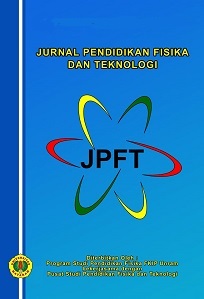Exploring the Correlation between Conceptual Understanding and Creativity Using Google Sites in Physics Learning
DOI:
10.29303/jpft.v10i2.7687Published:
2024-12-24Issue:
Vol. 10 No. 2 (2024): July - DecemberKeywords:
Relationship, Concept Understanding, Creativity, Google SitesArticles
Downloads
How to Cite
Downloads
Metrics
Abstract
This study is one of the first to explore the potential of Google Sites as an interactive medium to simultaneously enhance conceptual understanding and creativity in physics education. The research aimed to determine the relationship between conceptual understanding and students' creativity. This study was conducted at SMA Negeri 1 Narmada with the research subjects being students of class XI MIPA 5. Data were collected using a test instrument. The correlation test analysis was conducted based on the results of the students' pretest and posttest. The results showed that the average pretest and posttest of students were obtained respectively of 39.80 and 84.71 for conceptual understanding and 36.76 and 80.91 for creativity. The analysis revealed a significant positive correlation between conceptual understanding and students' creativity, with a sig. (2-tailed) value of <0.001. The correlation coefficient was 0.567 for the pretest, indicating a moderate strength of relationship, and 0.787 for the posttest, suggesting a strong relationship. These findings suggest that integrating Google Sites into physics learning can effectively foster both conceptual understanding and creativity, potentially offering a scalable solution for improving critical educational outcomes.
References
Adeyele, V. O. (2024). Relative effectiveness of simulation games, blended learning, and interactive multimedia in basic science achievement of varying ability pupils. Education and Information Technologies, 29(11), 14451–14470. https://doi.org/10.1007/s10639-023-12414-z
Al-Qoyyim, T. M., Pratama, R. H., Saputra, H. A., Satipa, D. A., Santika, H. D., Lestari, D., Martiana, R., Tanwiruddin, Juliana, D. & Gunada, I. W. (2022). Kelas Desain: Pelatihan Pembuatan Media Pembelajaran Fisika Berbasis Canva Untuk Mahasiswa Calon Guru. Jurnal Pengabdian Magister Pendidikan IPA, 5(4), 463-467. https://doi.org/10.29303/jpmpi.v5i4.2673
Arifuddin, A., Sutrio, S., & Taufik, M. . (2022). Pengembangan Bahan Ajar Kontekstual Berbasis Hands On Activity dalam Pembelajaran Fisika untuk Meningkatkan Pemahaman Konsep Fisika Peserta Didik. Jurnal Ilmiah Profesi Pendidikan, 7(2c), 894–900. https://doi.org/10.29303/jipp.v7i2c.631
Gunawan, G. (2015). Model Pembelajaran Sains Berbasis ICT. Mataram: FKIP Universitas Mataram.
Gunawan, G., Harjono, A., & Sutrio, S. (2017). Multimedia Interaktif dalam Pembelajaran Konsep Listrik bagi Calon Guru. Jurnal Pendidikan Fisika Dan Teknologi (JPFT), 1(1), 9–14. https://doi.org/10.29303/jpft.v1i1.230
Harjono, A., Gunawan, Busyairi, A. 2020. Pengembangan Media Pembelajaran. Mataram: Einstein College.
Hidayat, H., Hidayat, O. S. ., & Widiasih, W. (2023). Development of Google Sites-Based Learning Resources to Improve Mastery of Concepts and Process Skills in Electrical Circuit Materials. Jurnal Penelitian Pendidikan IPA, 9(6), 4624–4631. https://doi.org/10.29303/jppipa.v9i6.3612
Hidayat, R. K., Sahidu, H., & Gunada, I. W. (2022). Pengembangan Perangkat Pembelajaran Berbasis Inkuiri Terbimbing Terintegritas dengan Karakter untuk Meningkatkan Pemahaman Konsep Fisika Peserta Didik. Jurnal Ilmiah Profesi Pendidikan, 7(2), 285–291. https://doi.org/10.29303/jipp.v7i2.462
Johdi, H., Gunawan, G., Ayub, S., & Kosim, K. (2024). The Effectiveness of Interactive Google Sites-Based Learning Media on Students' Conceptual Understanding. Indonesian Journal of STEM Education, 6(2), 55-62.
Kosim, K., Hikmawati, H., & Mahrus, M. (2019). Analisis Kemampuan Kreativitas Mahasiswa Fisika Fkip Unram Dengan Berbantuan Multireprensentasi Design Tes Dalam Penguasaan Materi Gelombang Dan Optik. Jurnal Penelitian Pendidikan IPA, 5(1). https://doi.org/10.29303/jppipa.v5i1.203
Murniati, M., Ayub, S., & Sahidu, H. (2020). Pengaruh Model Pembelajaran Coneccting, Organizing, Reflecting, Extending (CORE) Terhadap Pemahaman Konsep Fisika Dan Kemampuan Berpikir Kritis. Jurnal Pijar Mipa, 15(2), 116–121. https://doi.org/10.29303/jpm.v15i2.1475
Oo, T. Z., Kadyirov, T., Kadyjrova, L., & Józsa, K. (2024). Design-based learning in higher education: Its effects on students’ motivation, creativity and design skills. Thinking Skills and Creativity, 53, 101621. https://doi.org/10.1016/j.tsc.2024.101621
Peşman, H., Arı, Ü., Cirit, D.K. & Ayazgök, B. (2024). Effect of Amount of Guidance in Inquiry-Based Physics Laboratory on Conceptual Understanding and Metacognitive Awareness. Science & Education, 33(6), 1-21 . https://doi.org/10.1007/s11191-024-00595-z
Roflin, E., Rohana, Riana, F. (2022). Analisis Korelasi dan Regresi. Jawa Tengah: PT. Nasya Expanding Management.
Sahidu, H., Gunawan, G., Rokhmat, J., & Rahayu, S. (2018). Pengembangan Perangkat Pembelajaran Fisika Berorientasi Pada Kreativitas Calon Guru. Jurnal Pendidikan Fisika dan Teknologi, 4(1), 1-6.
Zuhdi, M., & Makhrus, M. (2020). Peningkatan Pemahaman Konsep Fisika Dasar Melalui Konflik Kognitif dengan Pertanyaan Tak Terduga. Jurnal Pendidikan Fisika Dan Teknologi (JPFT), 6(2), 264–269. https://doi.org/10.29303/jpft.v6i2.2121
Author Biographies
Haerul Johdi, Universitas Mataram
Gunawan Gunawan, University of Mataram
Physics Education Study Program
Syahrial Ayub, University of Mataram
Physics Education Study Program
Kosim Kosim, University of Mataram
Physics Education Study Program
License
Copyright (c) 2024 Haerul Johdi, Gunawan Gunawan, Syahrial Ayub, Kosim Kosim

This work is licensed under a Creative Commons Attribution-ShareAlike 4.0 International License.
Authors who publish with Jurnal Pendidikan Fisika dan Teknologi (JPFT) agree to the following terms:
- Authors retain copyright and grant the journal right of first publication with the work simultaneously licensed under a Creative Commons Attribution License 4.0 International License (CC-BY-SA License). This license allows authors to use all articles, data sets, graphics, and appendices in data mining applications, search engines, web sites, blogs, and other platforms by providing an appropriate reference. The journal allows the author(s) to hold the copyright without restrictions and will retain publishing rights without restrictions.
- Authors are able to enter into separate, additional contractual arrangements for the non-exclusive distribution of the journal's published version of the work (e.g., post it to an institutional repository or publish it in a book), with an acknowledgement of its initial publication in Jurnal Pendidikan Fisika dan Teknologi (JPFT).
- Authors are permitted and encouraged to post their work online (e.g., in institutional repositories or on their website) prior to and during the submission process, as it can lead to productive exchanges, as well as earlier and greater citation of published work (See The Effect of Open Access).











